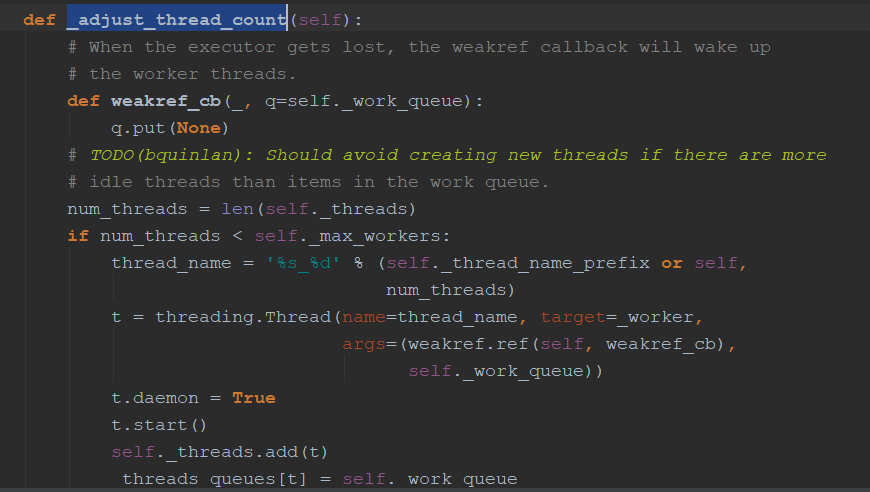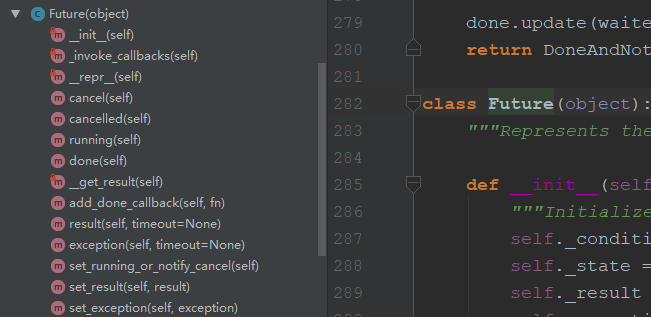一.python中的GIL(Global Interpreter Lock)
详情:https://www.cnblogs.com/SuKiWX/p/8804974.html
介绍:
GIL:全局解释器锁(Cpython中才有,Jpython没有,pypy是去gil的);
cpython:pyhon中的一个线程对应C语言中的一个线程;
gil使得同一个时刻只有一个线程在一个cpu上执行字节码,无法将多个线程映射到多cpu上;
gil在一些情况下会释放,是结合字节码和时间片释放(Python2和Python3有差别),gil在遇到io操作的时候会主动释放
#gil会释放,最后的结果不定,释放的位置不定 import threading total=1 def add(): global total for i in range(1000000): total+=1 def decs(): global total for i in range(1000000): total-=1 thread1=threading.Thread(target=add) thread2=threading.Thread(target=decs) thread1.start() thread2.start() thread1.join() thread2.join() print(total)
注:
Python GIL其实是功能和性能之间权衡后的产物,它尤其存在的合理性,也有较难改变的客观因素。从本分的分析中,我们可以做以下一些简单的总结:
-
-
-
- 因为GIL的存在,只有IO Bound场景下得多线程会得到较好的性能
- 如果对并行计算性能较高的程序可以考虑把核心部分也成C模块,或者索性用其他语言实现
- GIL在较长一段时间内将会继续存在,但是会不断对其进行改进
-
-
二.python多线程编程
1.利用Thread实例实现多线程:
这里子线程默认为非守护线程(主线程运行完,子线程不会退出,继续运行完)
# 对于io操作,多线程和多进程性能差别不大 # 通过Thread实例化 import time import threading def get_detail_html(url): print('我获取详情内容了') time.sleep(2) print('我获取内容完了') def get_detail_url(url): print('我获取url了') time.sleep(2) print('我获取url完了') if __name__=='__main__': thread1=threading.Thread(target=get_detail_html,args=('',)) thread2=threading.Thread(target=get_detail_url,args=('',)) start_time=time.time() thread1.start() thread2.start() #时间非常小,是运行代码的时间差,而不是2秒 #这样运行一共有三个线程,主线程和其他两个子线程(thread1,thread2),而且是并行的,子线程启动后,主线程仍然往下运行,因此时间不是2秒 #守护线程(主线程退出,子线程就会kill掉) print('last time:{}'.format(time.time()-start_time))


共三个进程,主线程和两个子线程
2.守护线程:(主线程退出,子线程就会被kill掉)
import time import threading def get_detail_html(url): print('我获取详情内容了') time.sleep(4) print('我获取内容完了') def get_detail_url(url): print('我获取url了') time.sleep(2) print('我获取url完了') if __name__=='__main__': thread1=threading.Thread(target=get_detail_html,args=('',)) thread2=threading.Thread(target=get_detail_url,args=('',)) #将线程1设置成守护线程(主线程退出,该线程就会被kill掉),但会等线程2运行完(非守护线程) thread1.setDaemon(True) start_time=time.time() thread1.start() thread2.start() print('last time:{}'.format(time.time()-start_time))
线程1未运行完退出
3.join():等某个子线程执行完在继续执行主线程代码:
import time import threading def get_detail_html(url): print('我获取详情内容了') time.sleep(4) print('我获取内容完了') def get_detail_url(url): print('我获取url了') time.sleep(2) print('我获取url完了') if __name__=='__main__': thread1=threading.Thread(target=get_detail_html,args=('',)) thread2=threading.Thread(target=get_detail_url,args=('',)) start_time=time.time() thread1.start() thread2.start() #等待两个线程执行完 thread1.join() thread2.join() print('last time:{}'.format(time.time()-start_time))

执行时间是线程最大时间(并发执行)
4.继承Thread实现多线程(代码较复杂时):
import time import threading class GetDetailHtml(threading.Thread): def __init__(self, name): super().__init__(name=name) def run(self): print('我获取详情内容了') time.sleep(4) print('我获取内容完了') class GetDetailUrl(threading.Thread): def __init__(self,name): super().__init__(name=name) def run(self): print('我获取url了') time.sleep(2) print('我获取url完了') if __name__=='__main__': thread1=GetDetailHtml('get_detail_html') thread2=GetDetailUrl('get_detail_url') start_time=time.time() thread1.start() thread2.start() #等待两个线程执行完 thread1.join() thread2.join() print('last time:{}'.format(time.time()-start_time))
三.线程间通信-Queue
1.线程通信方式——共享变量:(全局变量或参数等)
注:共享变量的方式是线程不安全的操作(不推荐)

1 import time 2 import threading 3 url_lists = [] 4 def get_detail_html(): 5 #可以单独放在某一个文件管理(注意引入时要引用文件) 6 global url_lists 7 url_lists=url_lists 8 while True: 9 if len(url_lists): 10 url=url_lists.pop() 11 print('我获取详情内容了') 12 time.sleep(4) 13 print('我获取内容完了') 14 def get_detail_url(url_lists): 15 while True: 16 print('我获取url了') 17 time.sleep(2) 18 for i in range(20): 19 url_lists.append('url'+str(i)) 20 print('我获取url完了') 21 if __name__ == '__main__': 22 thread_url=threading.Thread(target=get_detail_url,args=(url_lists,)) 23 thread_url.start() 24 #开启十个线程爬取详情 25 for i in range(10): 26 thread_html=threading.Thread(target=get_detail_html,) 27 thread_html.start()
2.通过queue的方式进行线程同步:
注:是线程安全的(Queue本身就是线程安全的【使用了线程锁的机制】,使用了双端队列,deque)
Queue中的方法:qsize()查看对列大小,empty()判断队列是否为空,full()判断队列是否满,满了的话put方法就会阻塞,等待有空位加入,put()将数据放入队列,默认是阻塞的(block参数,可以设置成非阻塞,还有timeout等待时间),get()从队列取数据


1 import time 2 import threading 3 from queue import Queue 4 url_lists = [] 5 def get_detail_html(queue): 6 while True: 7 url=queue.get() 8 print('我获取详情内容了') 9 time.sleep(4) 10 print('我获取内容完了') 11 def get_detail_url(queue): 12 while True: 13 print('我获取url了') 14 time.sleep(2) 15 for i in range(20): 16 queue.put('url'+str(i)) 17 print('我获取url完了') 18 if __name__ == '__main__': 19 #设置队列最大值1000,过大对内存会有很大影响 20 urls_queue=Queue(maxsize=1000) 21 thread_url=threading.Thread(target=get_detail_url,args=(urls_queue,)) 22 thread_url.start() 23 #开启十个线程爬取详情 24 for i in range(10): 25 thread_html=threading.Thread(target=get_detail_html,args=(urls_queue,)) 26 thread_html.start() 27 #执行该方法才能执行退出,和join成对出现 28 urls_queue.task_done() 29 urls_queue.join()
四. 线程同步(Lock、RLock、Semaphores、Condition)
问题:如例一中的问题,最后的结果不正确且不稳定,是因为在字节码运行时,线程随时可能跳转,导致赋值不正确,因此需要一个锁,让某段代码运行时,另一代码段不运行
1.Lock:锁住的代码段都只能有一个代码段运行
获取(acquire)和释放(release)锁都需要时间:因此用锁会影响性能;还有可能引起死锁(互相等待,A和B都需要a,b两个资源,A获取了a,B获取了B,A等待b,B等待a或则未释放锁再次获取);
产生死锁的四个条件:互斥条件;不剥夺条件;请求和保持条件;循环等待条件

1 import threading 2 from threading import Lock 3 total=1 4 lock=Lock() 5 def add(): 6 global total 7 for i in range(1000000): 8 #获取锁 9 lock.acquire() 10 total+=1 11 #释放锁,释放后其他才能获取 12 lock.release() 13 14 def decs(): 15 global total 16 for i in range(1000000): 17 lock.acquire() 18 total-=1 19 lock.release() 20 thread1=threading.Thread(target=add) 21 thread2=threading.Thread(target=decs) 22 thread1.start() 23 thread2.start() 24 thread1.join() 25 thread2.join() 26 print(total)
2.RLock(可重入的锁):在一个线程中可以,可以连续多次acquire(获取资源),一定要注意acquire的次数要和release的次数一致

3.Condition:条件变量(用于复杂的线程间同步)
3.1使用锁进行先后对话:发现先启动的线程把话先说完(第一个线程启动后运行完,第二个线程还没有启动,或者还未切换到另一个线程)
 View Code
View Code3.2通过condition实现:
(通过调用with方法(实际是__enter__魔法函数),也可以使用acquire()方法【如self.conf.acquire()】,但记得一定要release()之后才能调用其他函数【wait(),notify()】,还有注意线程启动顺序【先接收方先启动,否则接收不到】),Condition有两层锁,一把地层锁,会在线程调用了wait()方法时释放,上面的锁会在每次调用wait()时分配一把锁并放入到condition的等待队列中,等待notify()方法的唤醒
Condition重要函数:acquire(),release()【都调用了Lock的acquire,release】,wait()【允许等待某个通知在操作,会获取一把锁并把Condition中的锁释放掉】,notify()【发送通知,释放锁】

1 import threading 2 3 4 5 class LYQ1(threading.Thread): 6 def __init__(self, cond): 7 super().__init__(name="LYQ1") 8 self.cond = cond 9 10 def run(self): 11 with self.cond: 12 print('LYQ1:你好,我是{}'.format(self.name)) 13 #输出后发出通知 14 self.cond.notify() 15 self.cond.wait() 16 print('LYQ1:哈哈') 17 self.cond.notify() 18 self.cond.wait() 19 print('LYQ1:嘿嘿') 20 self.cond.notify() 21 22 23 class LYQ2(threading.Thread): 24 def __init__(self, cond): 25 super().__init__(name="LYQ2") 26 self.cond = cond 27 28 def run(self): 29 with self.cond: 30 #等待通知 31 self.cond.wait() 32 print('LYQ2:你好,我是{}'.format(self.name)) 33 self.cond.notify() 34 self.cond.wait() 35 print('LYQ2:好的'.format(self.name)) 36 self.cond.notify() 37 self.cond.wait() 38 print('LYQ2:好久不见') 39 self.cond.notify() 40 41 42 if __name__ == "__main__": 43 cond = threading.Condition() 44 lyq1 = LYQ1(cond=cond) 45 lyq2 = LYQ2(cond=cond) 46 #注意启动顺序,如果先启动lyq1,发送通知确没有接收(lyq2还没有启动) 47 lyq2.start() 48 lyq1.start() 49 ''' 50 输出: 51 LYQ1:你好,我是LYQ1 52 LYQ2:你好,我是LYQ2 53 LYQ1:哈哈 54 LYQ2:好的 55 LYQ1:嘿嘿 56 LYQ2:好久不见'''
4.Semaphores:(有一个参数value可以控制线程(并发数),调用acquire方法value就会减一,如果减少到为0就会阻塞在那儿等待有空位,调用release()value就会加一)【线程数量过多会影响切换线程的效率】
Semaphores内部实质是用Condition完成的,Queue实质也是;
用来控制进入数量的锁(如文件写一般只能一个线程,读可以允许同时多个线程读。)

1 # 控制线程的数量 2 from threading import Semaphore 3 import threading 4 import time 5 6 7 class UrlProducer(threading.Thread): 8 def __init__(self, sem): 9 super().__init__() 10 self.sem = sem 11 12 def run(self): 13 for i in range(20): 14 #调用acquire方法,Semaphore中的value就会减一(value),如果为0就阻塞在这儿 15 self.sem.acquire() 16 html_get = HtmlGet('url' + str(i),sem) 17 html_get.start() 18 19 20 class HtmlGet(threading.Thread): 21 def __init__(self, url,sem): 22 super().__init__() 23 self.url = url 24 self.sem=sem 25 26 def run(self): 27 time.sleep(2) 28 print('获取网页成功') 29 #调用release方法,Semaphore中的value就会加一(value) 30 self.sem.release() 31 32 33 if __name__ == '__main__': 34 #允许并发的个数 35 sem=Semaphore(3) 36 urlproducer = UrlProducer(sem) 37 urlproducer.start()
五.concurrent线程池编码
1.为什么需要线程池:
提供了数量控制,获取线程的状态及返回值;当一个线程完成的时候主线程能立即知道;futures能让多线程和多进程编码接口一致
2.ThreadPoolExecutor中重要函数:
submit():通过submit函数提交执行的函数到线程池,立即返回值(不会阻塞);
done():done()判断某个任务是否执行成功;
result():获取返回值;
cance():取消某个任务(还未执行,执行中不能取消);
wait()让主线程阻塞等待子线程完成,可以添加参数等待多长时间就不等待了
3.获取已经完成的任务:
as_completed() [from concurrent.futures import ThreadPoolExecutor,as_completed];
map(属于ThreadPoolExecutor)

1 #as_completed会将成功的url的返回值yield出去 2 from concurrent.futures import ThreadPoolExecutor,as_completed,wait 3 import time 4 def get_html(times): 5 time.sleep(times) 6 print('get success {}'.format(times)) 7 return times 8 9 excutor=ThreadPoolExecutor(max_workers=2) 10 # #通过submit函数提交执行的函数到线程池,立即返回值(不会阻塞) 11 # ret1=excutor.submit(get_html,(3)) 12 # #done()判断函数是否执行成功 13 # print(ret1.done()) 14 # print(ret1.cancel()) 15 # ret2=excutor.submit(get_html,(2)) 16 # print(ret2.done()) 17 # #result()获取返回值 18 # print(ret1.result()) 19 urls=[2,3,4] 20 #获取已经完成的任务 21 all_task=[excutor.submit(get_html,(url)) for url in urls] 22 #wait(让主线程阻塞等待子线程完成),可以 23 wait(all_task,return_when='FIRST_COMPLETED') 24 print('haha') 25 # for future in as_completed(all_task): 26 # data=future.result() 27 # print(data) 28 # for data in excutor.map(get_html,urls): 29 # print(data)
4:ThreadPoolExecutor源码简介:
submit方法会加一把锁,创建Future,然后放入WorkItem(执行单元),将执行单元放入执行队列中,_adjust_thread_count()会比较启动得线程数量和最大线程数量,如果小于就会启动一个线程放入_threads里面,_threads里面执行的是_worker()函数,参数为work_que,获取WorkItem,然后调用里面的run()方法,将值设置到future中去。





Future中的方法,cancel(),done()等等都是判断状态,result()是会阻塞的,调用Condition()
六.多进程编程-multiprocessing
1.和多线程对比:
·1.1多进程开销大,多线程开销小;
1.2耗CPU的操作,多进程编程比多线程编程好很多,对于IO操作来说,使用多线程操作比多进程好(线程切换比进程切换性能高)
2.例:
1.1对于耗CPU的操作(多进程优于多线程):

1 from concurrent.futures import ThreadPoolExecutor,ProcessPoolExecutor,as_completed 2 import time 3 4 def fib(n): 5 if n<=2: 6 return 1 7 return fib(n-2)+fib(n-1) 8 if __name__=='__main__': 9 #代码要放在这里面,不然可能抛异常 10 with ThreadPoolExecutor(3) as excutor: 11 start_time=time.time() 12 all_task=[excutor.submit(fib,num) for num in range(25,40)] 13 for future in as_completed(all_task): 14 data=future.result() 15 print('结果:'+str(data)) 16 print('多线程所需时间:'+str(time.time()-start_time)) 17 ''' 18 多线程所需时间:72.10901117324829 19 ''' 20 21 with ProcessPoolExecutor(3) as excutor: 22 start_time=time.time() 23 all_task=[excutor.submit(fib,num) for num in range(25,40)] 24 for future in as_completed(all_task): 25 data=future.result() 26 print('结果:'+str(data)) 27 print('多进程所需时间:'+str(time.time()-start_time)) 28 ''' 29 多进程所需时间:43.14996862411499 30 '''
1.2对于IO操作,多线程由于多进程:

1 from concurrent.futures import ThreadPoolExecutor,ProcessPoolExecutor,as_completed 2 import time 3 4 def random_sleep(n): 5 time.sleep(n) 6 return n 7 if __name__=='__main__': 8 #代码要放在这里面,不然可能抛异常 9 with ThreadPoolExecutor(3) as excutor: 10 start_time=time.time() 11 all_task=[excutor.submit(random_sleep,num) for num in [2]*30] 12 for future in as_completed(all_task): 13 data=future.result() 14 print('休息:'+str(data)+'秒') 15 print('多线程所需时间:'+str(time.time()-start_time)) 16 ''' 17 多线程所需时间:20.010841131210327 18 ''' 19 20 with ProcessPoolExecutor(3) as excutor: 21 start_time=time.time() 22 all_task=[excutor.submit(random_sleep,num) for num in [2]*30] 23 for future in as_completed(all_task): 24 data=future.result() 25 print('休息:'+str(data)+'秒') 26 print('多进程所需时间:'+str(time.time()-start_time)) 27 ''' 28 20.755817651748657 29 '''
3.进程有趣的例子:

1 import os 2 import time 3 #fork只能用于Linux/Unix 4 #进程间数据是隔离的,每个进程都有完整的数据,fork()会将父进程代码复制一遍在运行(fork后的代码) 5 pid=os.fork() 6 print('LYQ') 7 if pid==0: 8 print('子进程:{},父进程:{}'.format(os.getpid(),os.getppid())) 9 else: 10 print('我是父进程:{}'.format(pid)) 11 #暂停两秒,父进程还没有退出,子进程可以运行完,父进程退出就可以kill掉子进程 12 #不暂停的话,父进程退出,子进程仍然在运行,输出 13 time.sleep(2) 14 ''' 15 暂停的输出: 16 LYQ 17 我是父进程:8587 18 LYQ 19 子进程:8587,父进程:8578 20 21 不暂停的输出: 22 LYQ 23 我是父进程:8587 24 [root@izwz97n253zzwjtudbqt5uz ~]# LYQ 25 子进程:8587,父进程:1 26 '''
4.multiprocessing:(比ProcessPoolExecutor更底层【基于multiprocessing实现】,推荐ProcessPoolExecutor更好的设计,和ThreadPoolExecutor相似):

1 import time 2 import multiprocessing 3 def get_html(n): 4 time.sleep(n) 5 print('sub_process success') 6 return n 7 8 if __name__=='__main__': 9 process=multiprocessing.Process(target=get_html,args=(1,)) 10 #获取进程号,没有start之前为None 11 print(process.pid) 12 process.start() 13 print(process.pid) 14 process.join() 15 print('main_process success')
5进程池:

1 ...... 2 pool=multiprocessing.Pool(3) 3 #异步提交任务 4 # result=pool.apply_async(get_html,args=(2,)) 5 # #关闭不在进入进程池 6 # pool.close() 7 # pool.join() 8 # print(result.get()) 9 #和执行顺序一样 10 for result in pool.imap(get_html,[1,5,3]): 11 print('{} sleep success'.format(result)) 12 #和先后完成顺序一样 13 for result in pool.imap_unordered(get_html, [1, 5, 3]): 14 print('{} sleep success'.format(result))
七.进程间通信
1.共享全局变量在多进程中不适用(会把数据复制到子进程中,数据是独立的,修改也不会影响),quue中的Queue也不行,需要做一些处理

1 from multiprocessing import Queue,Process 2 import time 3 def producer(queue): 4 queue.put('a') 5 time.sleep(2) 6 7 def consumer(queue): 8 time.sleep(2) 9 data=queue.get() 10 print(data) 11 12 if __name__=='__main__': 13 queue=Queue(10) 14 pro_producer=Process(target=producer,args=(queue,)) 15 pro_consumer=Process(target=consumer,args=(queue,)) 16 pro_producer.start() 17 pro_consumer.start() 18 pro_producer.join() 19 pro_consumer.join()
2.multiprocessing中的Queue不能用于进程池(需要用到manager):
queue=Manager().Queue(10)

1 from queue import Queue——>用于多线程 2 from multiprocessing import Queue——>用于非进程池的多进程通信 3 from multiprocessing import Manager——>manager.Queue()用于进程池通信
3.通过Pipe进行进程间通信(管道),pipe只能适用于两个进程 ,Pipe性能高于queue

1 from multiprocessing import Pipe 2 import time 3 def producer(pipe): 4 pipe.send('a') 5 time.sleep(2) 6 7 def consumer(pipe): 8 time.sleep(2) 9 data=pipe.recv() 10 print(data) 11 12 if __name__=='__main__': 13 #通过Pipe进行进程间通信(管道),pipe只能适用于两个进程 14 recv_pipe,send_pipe=Pipe() 15 queue=Manager().Queue(10) 16 pro_producer=Process(target=producer,args=(send_pipe,)) 17 pro_consumer=Process(target=consumer,args=(recv_pipe,)) 18 pro_producer.start() 19 pro_consumer.start() 20 pro_producer.join() 21 pro_consumer.join()
4.进程间共享内存(Manager):

1 from multiprocessing import Manager,Process 2 3 def add_data(pro_dict, key, value): 4 pro_dict[key] = value 5 6 if __name__=='__main__': 7 #常用的类型都有 8 9 process_dict=Manager().dict() 10 fir=Process(target=add_data,args=(process_dict,'name1','LYQ1')) 11 sed = Process(target=add_data, args=(process_dict, 'name2', 'LYQ2')) 12 fir.start() 13 sed.start() 14 fir.join() 15 sed.join() 16 print(process_dict)

